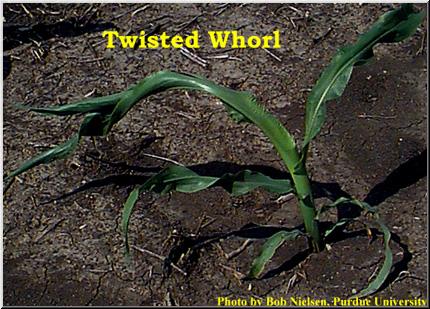

![]() ost everyone agrees that Indiana weather conditions
during the past 30 days or so can only be described as “crappy” for
the growth and development of the state's corn crop. Daily high temperatures
have been primarily in the 60's and low 70's. Daily low temperatures have been
in the 50's and even 40's. About the only good news overheard down at the Chat
'n Chew Café is that surface soil moisture levels have been replenished
in most areas of the state, although in many areas rainfall has been excessive.
ost everyone agrees that Indiana weather conditions
during the past 30 days or so can only be described as “crappy” for
the growth and development of the state's corn crop. Daily high temperatures
have been primarily in the 60's and low 70's. Daily low temperatures have been
in the 50's and even 40's. About the only good news overheard down at the Chat
'n Chew Café is that surface soil moisture levels have been replenished
in most areas of the state, although in many areas rainfall has been excessive.
We know that warm, sunny weather will eventually return to the Hoosier state. We also know that corn, being a temperature-dependent crop, will respond to that onset of warm, sunny weather by shifting to a faster rate of development. Therein lies the cause for issuing this fearmonger alert.
When periods of slow corn development (typically, cool cloudy weather) are followed by a sharp transition to periods of rapid corn development (typically, warm sunny weather plus ample moisture), scattered plants throughout fields may begin exhibiting unusual symptoms of twisted whorls. The whorls of the affected plants appear tightly twisted, bend over at right angles, and remain unfurled for quite some time.

One’s natural instincts would blame the twisted growth on herbicide injury. Where cell growth inhibitor herbicides are applied pre-plant or pre-emergence, shoot uptake of the herbicide by the emerging seedling can indeed result in twisted growth of the young plants. Late application of growth regulators can also cause twisted whorls in older plants when leaves and whorl intercept a substantial amount of the herbicide.
It is important to recognize, though, that twisted whorls of corn may appear in fields where none of this herbicide chemistry has been applied. Some hybrids react to a rapid change from poor to good growing conditions by basically going “bonkers” as their rate of development speeds up.
For some reason, the upper whorl of some plants sometimes won’t unfurl properly as if the rolled leaf tissue has lost its elasticity. Younger leaves deeper in the whorl continue to develop rapidly, but are unable to emerge from the tightly wrapped upper leaves. The subsequently tightly twisted whorl then bends and kinks from the pressure exerted from the younger leaves' continued growth.
The growth stage where I've observed this phenomenon in past years was around four to six visible leaf collars (somewhat less than knee-high). That growth stage accurately reflects that of early-planted corn right now and, in fact, I’ve received a few reports of the occurrence of the phenomenon from various areas of the state.
At the peak of the problem, the appearance of these plants is indeed unsettling and one would think that the whorls would never unfurl properly. Given another week, though, twisted whorls of most of the plants will unfurl and the plants subsequently develop normally.
If you didn't notice the twisted growth to begin with, you may notice the appearance of “yellow tops” across the field after the whorls unfurl. The younger leaves that had been trapped inside the twisted upper leaves emerge fairly yellow due to the fact that they had been shaded for quite some time. In addition to being fairly yellow, the leaves will exhibit a crinkly surface caused by their restricted expansion inside the twisted whorl. Another day or two will green these up and the problem will no longer be visible.
The Good News: Yield effects from periods of twisted growth caused by weather-related causes are minimal, if any.
For more images of this oddity, see the accompanying image gallery.